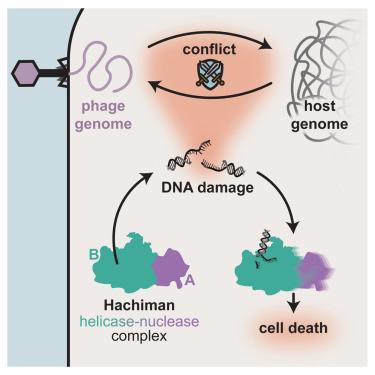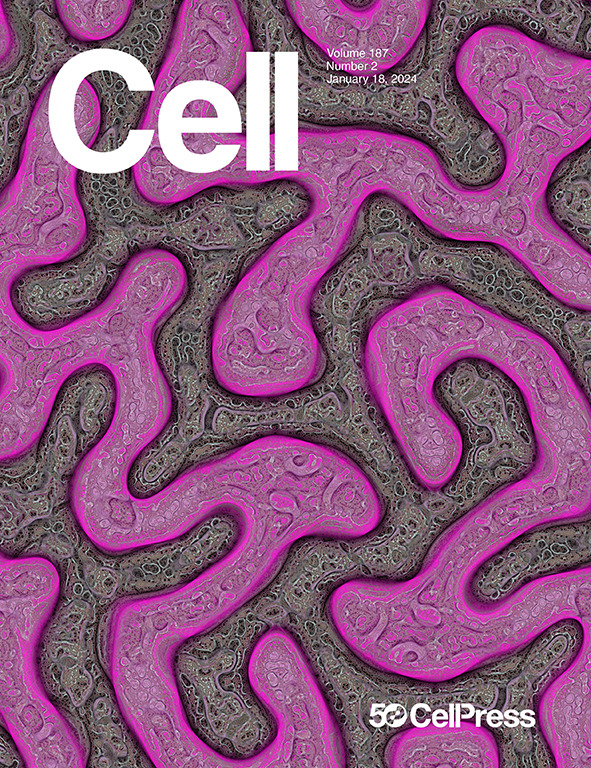广谱八幡抗虹吸虫防御复合体的基因组完整性感应
IF 45.5
1区 生物学
Q1 BIOCHEMISTRY & MOLECULAR BIOLOGY
引用次数: 0
摘要
Hachiman 是一种功能未知的广谱抗蚜虫防御系统。我们在这里发现,Hachiman 是一种异源二聚体核酸酶-蒜酶复合体,即 HamAB。HamA 以前是一种功能未知的蛋白质,是效应核酸酶。HamB 是感应螺旋酶。在监测完整的双链 DNA(dsDNA)时,HamB 限制 HamA 的活性。当 HamAB 复合物检测到 DNA 损伤时,HamB 螺旋酶活性会激活 HamA,释放核酸酶活性。Hachiman 激活会降解细胞中的所有 DNA,从而产生不含噬菌体和宿主 DNA 的 "幽灵 "细胞。我们用 DNA 破坏剂处理细胞,证明在没有噬菌体的情况下也能激活 Hachiman,这表明 Hachiman 能对异常的 DNA 状态做出反应。哈奇曼螺旋酶与真核生物和古细菌中的酶之间的系统发育相似性表明,哈奇曼螺旋酶与生命各领域中其他重要的螺旋酶具有深层的功能对称性。本文章由计算机程序翻译,如有差异,请以英文原文为准。

Genome integrity sensing by the broad-spectrum Hachiman antiphage defense complex
Hachiman is a broad-spectrum antiphage defense system of unknown function. We show here that Hachiman is a heterodimeric nuclease-helicase complex, HamAB. HamA, previously a protein of unknown function, is the effector nuclease. HamB is the sensor helicase. HamB constrains HamA activity during surveillance of intact double-stranded DNA (dsDNA). When the HamAB complex detects DNA damage, HamB helicase activity activates HamA, unleashing nuclease activity. Hachiman activation degrades all DNA in the cell, creating “phantom” cells devoid of both phage and host DNA. We demonstrate Hachiman activation in the absence of phage by treatment with DNA-damaging agents, suggesting that Hachiman responds to aberrant DNA states. Phylogenetic similarities between the Hachiman helicase and enzymes from eukaryotes and archaea suggest deep functional symmetries with other important helicases across domains of life.
求助全文
通过发布文献求助,成功后即可免费获取论文全文。
去求助
来源期刊

Cell
生物-生化与分子生物学
CiteScore
110.00
自引率
0.80%
发文量
396
审稿时长
2 months
期刊介绍:
Cells is an international, peer-reviewed, open access journal that focuses on cell biology, molecular biology, and biophysics. It is affiliated with several societies, including the Spanish Society for Biochemistry and Molecular Biology (SEBBM), Nordic Autophagy Society (NAS), Spanish Society of Hematology and Hemotherapy (SEHH), and Society for Regenerative Medicine (Russian Federation) (RPO).
The journal publishes research findings of significant importance in various areas of experimental biology, such as cell biology, molecular biology, neuroscience, immunology, virology, microbiology, cancer, human genetics, systems biology, signaling, and disease mechanisms and therapeutics. The primary criterion for considering papers is whether the results contribute to significant conceptual advances or raise thought-provoking questions and hypotheses related to interesting and important biological inquiries.
In addition to primary research articles presented in four formats, Cells also features review and opinion articles in its "leading edge" section, discussing recent research advancements and topics of interest to its wide readership.
 求助内容:
求助内容: 应助结果提醒方式:
应助结果提醒方式:


